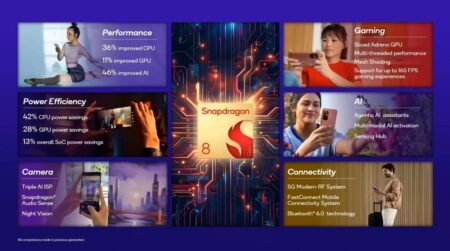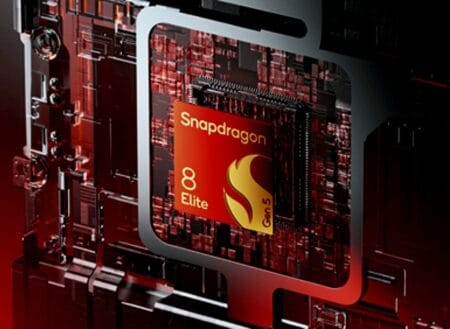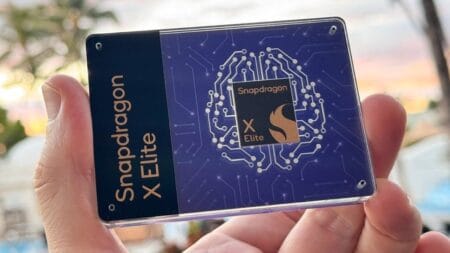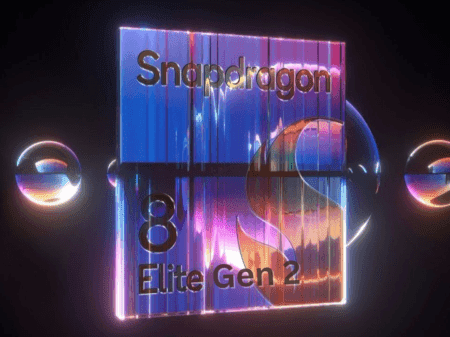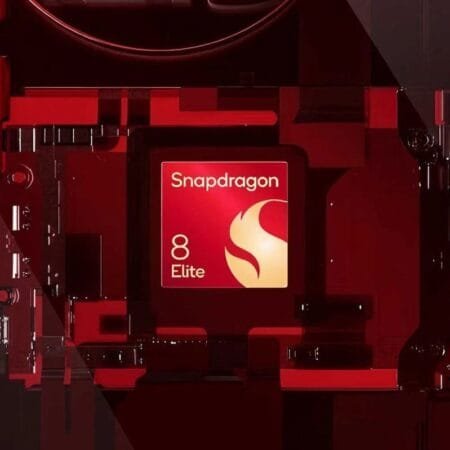Qualcomm is one of the leading manufacturers of system-on-chips (SoCs) for smartphones, tablets, and other devices. The company has a range of SoCs for different segments, from budget to flagship.
However, Qualcomm’s naming scheme for its SoCs has become increasingly confusing over the years, making it hard for consumers and developers to compare and choose the best SoC for their needs.
In this article, we will look at the latest leak of the Qualcomm Snapdragon 8s Gen 3, a new SoC that could be positioned between the Snapdragon 8 Gen 3 and the Snapdragon 8 Gen 2, but not better than either of them.

What is the Snapdragon 8s Gen 3?
The Snapdragon 8s Gen 3 is a rumored SoC that Qualcomm is reportedly working on. According to a leak by Digital Chat Station, a reliable source of information on Chinese social media, the Snapdragon 8s Gen 3 has the codename SM8635 and could come with the following specifications:
- A Cortex-X4 prime core clocked at 3.01GHz
- Four Cortex-A720 performance cores clocked at 2.61GHz
- Three Cortex-A520 efficiency cores clocked at 1.84GHz
- An Adreno 735 GPU
The leak also suggests that the Snapdragon 8s Gen 3 could be launched in the second half of 2024, possibly alongside some new devices from Xiaomi, Oppo, Vivo, and other brands.
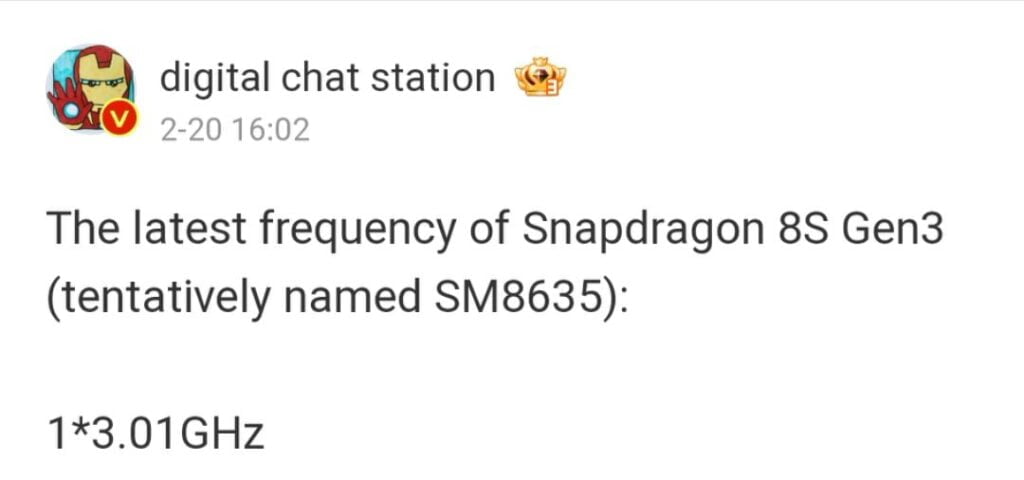
How does the Snapdragon 8s Gen 3 compare to the Snapdragon 8 Gen 3 and the Snapdragon 8 Gen 2?
Snapdragon 8 Gen 3 and the Snapdragon 8 Gen 2 are the current flagship SoCs from Qualcomm, powering some of the most popular and high-end Android devices in the market, such as the Samsung Galaxy S24, the OnePlus 12 and more. The Snapdragon 8 Gen 3 is the latest and most powerful SoC from Qualcomm, featuring a Cortex-X4 prime core clocked at 3.3GHz, three Cortex-A720 performance cores clocked at 3.2GHz, two Cortex-A720 at 3.0GHz, two Cortex-A520 efficiency cores clocked at 2.3GHz, and an Adreno 750 GPU.
The Snapdragon 8 Gen 2 is the predecessor of the Snapdragon 8 Gen 3, featuring a Cortex-X3 prime core clocked at 3.2GHz, two Cortex-A715 performance cores clocked at 2.8GHz, two cortex-A710 at 2.8GHz and three Cortex-A510 efficiency cores clocked at 2.0GHz, and an Adreno 740 GPU.
Based on the leaked specifications, the Snapdragon 8s Gen 3 does not seem to be better than either the Snapdragon 8 Gen 3 or the Snapdragon 8 Gen 2. The clock speeds of the Snapdragon 8s Gen 3 are lower than both the Snapdragon 8 Gen 3 and the Snapdragon 8 Gen 2, the codename of the Snapdragon 8s Gen 3 is lower than the Snapdragon 8 Gen 3 (SM8635 vs SM8650), and the GPU of the Snapdragon 8s Gen 3 is lower than the Snapdragon 8 Gen 3 (Adreno 735 vs Adreno 750). The only possible advantage of the Snapdragon 8s Gen 3 could be the use of the Cortex-X4 core, which is a newer and more advanced core design than the Cortex-X2 and the Cortex-X1. However, the performance difference between the Cortex-X4 and the Cortex-X2 or the Cortex-X1 may not be significant enough to justify the lower clock speeds and the lower GPU.
Why is the Snapdragon 8s Gen 3 a confusing addition to the flagship SoC lineup?
The Snapdragon 8s Gen 3 is a confusing addition to the flagship SoC lineup because it does not follow the usual convention of using the “S” suffix to indicate an incremental upgrade over the base model. For example, Apple uses the “S” suffix to denote a minor improvement over the previous generation of iPhones, such as the iPhone 6S, the iPhone XS, and the iPhone 12S. Similarly, Qualcomm has used the “S” suffix to denote a slight boost over the previous generation of SoCs, such as the Snapdragon 855 Plus, the Snapdragon 865 Plus, and the Snapdragon 888 Plus. However, the Snapdragon 8s Gen 3 does not seem to be an upgrade over the Snapdragon 8 Gen 3, but rather a downgrade or a sidegrade.
Moreover, the Snapdragon 8s Gen 3 adds to the already cluttered and complicated flagship SoC lineup from Qualcomm, which includes several variants and versions of the Snapdragon 8 series. For example, Qualcomm also has a “for Galaxy” or “Plus” version of the Snapdragon 8 Gen 3, which is exclusive to Samsung and offers a slightly higher clock speed and a better GPU than the regular Snapdragon 8 Gen 3. This means that there are at least seven different flagship SoCs from Qualcomm, going from most powerful to less powerful:
- Snapdragon 8 Gen 3 for Galaxy
- Snapdragon 8 Gen 3
- Snapdragon 8s Gen 3
- Snapdragon 8 Gen 2 for Galaxy / Snapdragon 8 Plus Gen 2
- Snapdragon 8 Gen 2
- Snapdragon 8 Plus Gen 1
- Snapdragon 8 Gen 1
This makes it very difficult for consumers and developers to compare and choose the best SoC for their needs, as the differences between them may not be clear or consistent. Furthermore, Qualcomm’s naming scheme for its SoCs is not only confusing at the flagship level, but also at the premium mid-range level, where there is a Snapdragon 7 Gen 3, a Snapdragon 7s Gen 2, and a Snapdragon 7 Plus Gen 2, but no Snapdragon 7 Gen 2.
What can Qualcomm do to simplify its SoC naming scheme?
We hope that Qualcomm considers another branding cleanup for its SoCs when it releases the Snapdragon 8s Gen 3, as it has become challenging to keep track of where its SoCs place against each other. Qualcomm could adopt a simpler and more consistent naming scheme for its SoCs, using numbers to indicate the segment and letters to indicate the generation. For example, Qualcomm could use the following naming scheme:
- Q1: The flagship SoC for the current year, such as Q1 2024
- Q1P: The “Plus” or “for Galaxy” version of the flagship SoC, offering a slight boost over the Q1, such as Q1P 2024
- Q2: The flagship SoC for the previous year, such as Q2 2023
- Q3: The premium mid-range SoC for the current year, such as Q3 2024
- Q4: The premium mid-range SoC for the previous year, such as Q4 2023
- Q5: The budget SoC for the current year, such as Q5 2024
- Q6: The budget SoC for the previous year, such as Q6 2023
This naming scheme would make it easier for consumers and developers to understand the relative performance and positioning of the SoCs, as well as the year of release. It would also avoid the confusion caused by using the “S” suffix or the “Gen” suffix inconsistently. Qualcomm could also use sub-numbers to indicate minor variations within the same segment and generation, such as Q1.1, Q1.2, Q1.3, and so on.
Qualcomm is a leader in the SoC industry, and we appreciate the innovation and quality that the company brings to the market. However, we also hope that the company simplifies its SoC naming scheme, as it would benefit both the consumers and the developers who use its products. The Snapdragon 8s Gen 3 is a confusing addition to the flagship SoC lineup, and we hope that Qualcomm clarifies its position and purpose when it launches.
Discover more from wazzuptechph
Subscribe to get the latest posts sent to your email.


